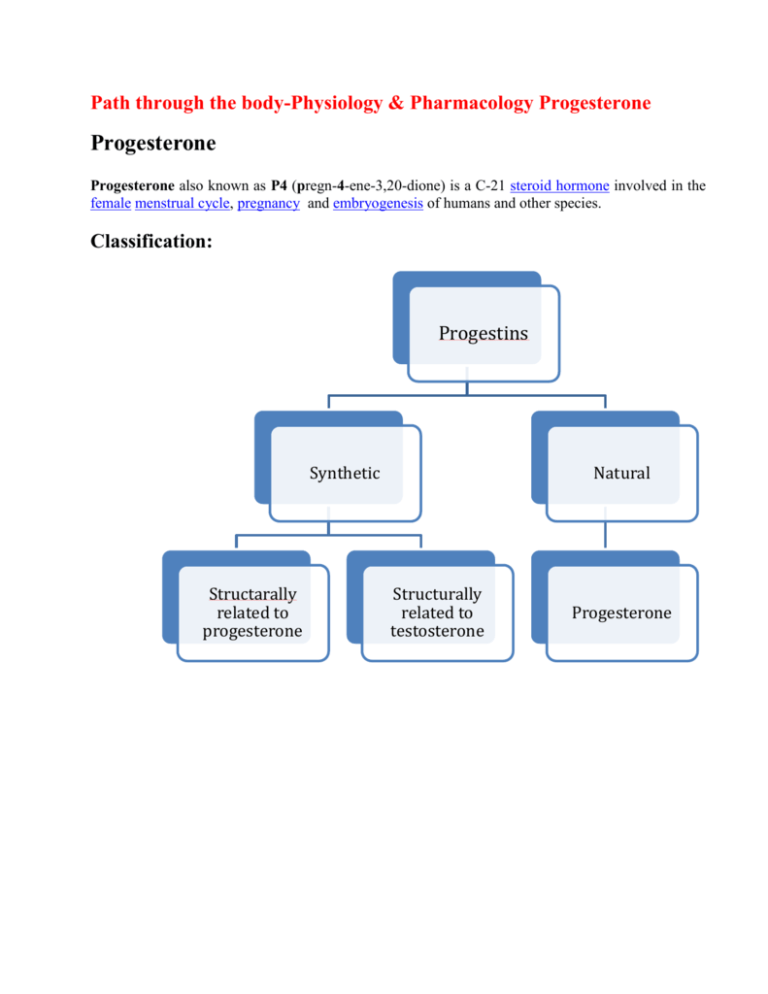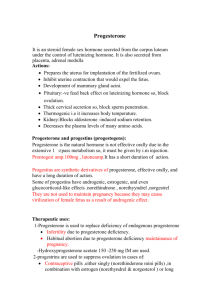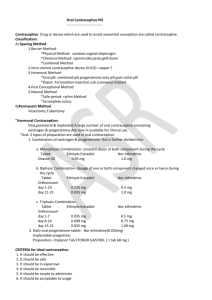Progesterone article
advertisement

Path through the body-Physiology & Pharmacology Progesterone Progesterone Progesterone also known as P4 (pregn-4-ene-3,20-dione) is a C-21 steroid hormone involved in the female menstrual cycle, pregnancy and embryogenesis of humans and other species. Classification: Progestins Synthetic Structarally related to progesterone Natural Structurally related to testosterone Progesterone Related to progesterone 19norprogesterone derivatives Pregnane derivatives Acetylated MPA Megesterol acetate Cyproterone acetate Chlormadinoneacetate (minipill) Nonacetylated Dydrogesterone (duphaston) Demegestone Nomegesterol Nestrone drosperinone Related to testosterone Ethinylated Estranes Norethindrone lynestrenol Norethinsterone (primolut-N) NORETHINSTERONE ACETATE (REGESTERONE) Nonethinylated Gonanes LNG (OVRAL) Desogestrel Gestodone norgestimate Dienogest Pregnane: Medroxy progesterone acetate - similar action as natural compound with lesser endometrial , stromal asynchrony. It is ideal for endometrial protection. Due to prolonged axis suppression it is not ideal for withdrawal bleeding. Didrogesterone -It induces production of progesteron induced blocking factor ( PIBF ) , thereby decreasing harmful Th 1 cells and increasing Th 2 cells which increases clinical pregnancy rates. Advantages : Being diuretic it prevents sodium retention. It has no adverse effect on B.P. , weight , blood clotting factors and lipoprotiens. Adrenal and renal function are unaffected. Estrane(I Generation) - norehisterone, norethynindiol and Gonane (II Generation) - levonorgestrel, norgestrel: Their strong inhibitory action on pituitary gonadotrophins and hemostatic activity make them effective contraceptives. III Generation : Desogestrel, gestodene, norgestimate - they are lipid friendly & potent antiovulatory. IV Generation: Drospirenone,dienogest,nomegestrol Micronised progesterone: It is Natural progesterone (decreasing the particle size increases absorption & bioavalability). Dose dependent increase of serum progesterone can be achieved. To fully protect endometrium- 300mg/day in divided doses ( mostly 100 mg day & 200mg night because sedation is the side effect) is required. After food maximum absorption is noted than on empty stomach. It is short acting and needs multiple doses It is lipid friendly. It favours diuresis (so useful in HRT as cardioprotective) It is suitable for treatment of LPD, DUB, HRT, premenstrual syndrome and progesterone challenge test. Chemistry: Progesterone is a compound with 21 carbon atom chain derived from cholesterol. It consists of four interconnected cyclic hydrocarbons, ketone and oxygenated functional groups, as well as two methyl branches. It is hydrophobic. Progesterone was independently discovered by four research groups.[2][3][4][5] Willard Myron Allen co-discovered progesterone with his anatomy professor George Washington Corner at the University of Rochester Medical School in 1933. Allen first determined its melting point, molecular weight, and partial molecular structure. He also gave it the name Progesterone derived from Progestational Steroidal ketone.[6] Source: Animal: Progesterone is produced in the ovaries (by the corpus luteum), the adrenal glands and during pregnancy, in the placenta. Progesterone is also stored in adipose tissue. In humans, during pregnancy at first, the progesterone is produced from the corpus luteum that has been "rescued" by the presence of human chorionic gonadotropins (hCG) from the conceptus.After the 8th week, production of progesterone shifts to the placenta. An additional source of progesterone is milk products. After consumption of milk products the level of bioavailable progesterone goes up. Plants Progesterone-like steroid called diosgenin is found in Dioscorea species of the yam family( native to Mexico) like Dioscorea mexicana, Dioscorea villosa and Dioscorea polygonoides. Progesterone can be produced from this diosgenin. Synthetic progesterone is called progestogens/progestins/gestagens. Advantages Disadvantages Bypasses first pass metabolism,rapid hepatic inactivation Androgenic ill effects So good oral absorption Fluid retention Good hemostats Decreases HDL Good contraceptives PMS like symptoms Not able to convey many of the biological benefits of native progesterone Synthesis: Biosynthesis: Top: Conversion of cholesterol (1) into pregnenolone (3) to progesterone (6). Bottom: Progesterone is important for aldosterone (mineralocorticoid) synthesis, as 17hydroxyprogesterone is for cortisol (glucocorticoid), and androstenedione for sex steroids. Cholesterol (1) undergoes double oxidation to produce 20,22-dihydroxycholesterol (2). This vicinal diol is then further oxidized with loss of the side chain starting at position C-22 to produce pregnenolone (3). This reaction is catalyzed by cytochrome P450scc. The conversion of pregnenolone to progesterone takes place in two steps. First, the 3-hydroxyl group is oxidized to a keto group (4) and second, the double bond is moved to C-4, from C-5 through a keto/enol tautomerization reaction. This reaction is catalyzed by 3beta-hydroxysteroid dehydrogenase/delta(5)-delta(4)isomerase. Progesterone in turn (see lower half of figure to the right) is the precursor of the mineralocorticoid aldosterone, and after conversion to 17-hydroxyprogesterone (another natural progestogen) of cortisol and androstenedione. Androstenedione can be converted to testosterone, estrone and estradiol. Pregnenolone and progesterone can also be synthesized by yeast. Laboratory An economical semisynthesis of progesterone from the plant steroid diosgenin isolated from yams was developed by Russell Marker in 1940 for the Parke-Davis pharmaceutical company. A total synthesis of progesterone was reported in 1971 by W.S. Johnson . The synthesis begins with reacting the phosphonium salt 7 with phenyl lithium and is followed by several steps of chemical reaction to produce progesterone. Levels In women, progesterone levels are relatively low during the preovulatory phase of the menstrual cycle, rise after ovulation, and are elevated during the luteal phase, as shown in diagram below. Progesterone levels tend to be < 2 ng/ml prior to ovulation, and > 5 ng/ml after ovulation. After the luteal-placental shift progesterone levels start to rise further and may reach 100-200 ng/ml at term. Progesterone levels are relatively low in children and postmenopausal women. Adult males have levels similar to those in women during the follicular phase of the menstrual cycle. Blood test results should always be interpreted using the reference ranges provided by the laboratory that performed the results. Pharmacokinetics: In liver Reduction hydroxylation Glucuronide derivatives Conjugation Excreted in urine & feces Used for detection of ovulation(urinary metabolite) Extensive first pass metabolism in liver & gut ¼ th reaches circulation Peak levels in 2 hrs T1/2 -30 min Reaches base line in 12 hrs So requires BD dosage Preparations T1/2 Dmpa 2-3 days Dydrogesterone (duphaston) 4-5 hrs Lng 16 hrs Gestedone 12-18hrs Desogestrel 12 hrs Norethiindrone 8hrs Physiological mechanisms: Progesterone exerts its primary action through the intracellular progesterone receptor although a distinct, membrane bound progesterone receptor has also been postulated. The mechanism includes: (1) steroid hormone diffusion across the cell membrane, (2) steroid hormone binding to receptor protein, (3) interaction of a hormone-receptor complex with nuclear DNA, (4) synthesis of messenger RNA (mRNA), (5) transport of the mRNA to the ribosomes, and finally, (6) protein synthesis in the cytoplasm that results in specific cellular activity. In addition, progesterone is a highly potent antagonist of the mineralocorticoid receptor (MR). It reduces the sodium-retaining activity of aldosterone. The Progesterone Receptor: The progesterone receptor is induced by estrogens at the transcriptional level and decreased by progestins at both the transcriptional and translational levels (probably through receptor phosphorylation). The progesterone receptor (in a fashion similar to the estrogen receptor) has two major forms, designated the A and B receptors. The two forms are expressed by a single gene; the two forms are a consequence of transcription from distinctly different promoters, in a complex system of transcription regulation. Each form is associated with additional proteins, which are important for folding of the polypeptide into a structure that allows hormone binding and receptor activity. The molecular weight of A is 94,000 and B, 114,000, with 933 amino acids, 164 more than A. On the progesterone receptor, TAF-1 is located in a 91-amino acid segment just upstream of the DNA-binding domain. TAF-2 is located in the hormone-binding domain. A fragment missing the hormone-binding domain activates transcription to levels comparable to fulllength hormone-activated B receptors, and higher than that with the A receptor, thus beyond that of TAF-1 alone. In appropriate cells, therefore, BUS contains a third activation domain, TAF-3, and can autonomously activate transcription or it can synergize with the other TAFs. In the absence of hormone binding, the C-terminal region of the progesterone receptor exerts an inhibitory effect on transcription.93 Progesterone agonists induce a conformational change that overcomes the inherent inhibitory function within the carboxy tail of the receptor. Binding with a progesterone antagonist produces a structural change that allows the inhibitory actions to be maintained. Effects Progesterone has a number of physiological effects that are amplified in the presence of estrogen. Estrogen through estrogen receptors upregulates the expression of progesterone receptors. Some Progestational Compounds and their Biological Activities Agent Progesterone & derivatives Activities Estrogenic androgenic antiantiandrogenic estrogenic anabolic Progesterone - - + - - Hydroxyprogesterone capoate -/+ -/+ - - - Medroxyprogesterone acetate - + + - - Megestrol acetate - + - + - - - -/+ - - - - - - 17 ethinyl testosterone derivatives & testosterone derivatives Dimethisterone 19-Nor-testosterone derivatives Desogestrel Norethynodrel + - - - - Norethindrone -/+ + + - + Ethynodiol acetate -/+ + + - L-Norgestrel - + + - + Reproductive system: It causes suppression of H-P-O axis, inhibits preovulatory surge and thereby ovulation. Progesterone modulates the activity of CatSper (cation channels of sperm) voltage-gated Ca2+ channels. Since eggs release progesterone, sperm may use progesterone as a homing signal to swim toward eggs (chemotaxis). Progesterone converts the endometrium to its secretory stage to prepare the uterus for implantation. At the same time progesterone affects the vaginal epithelium and cervical mucus, making it thick and impenetrable to sperm. If pregnancy does not occur, progesterone levels will decrease, leading, in the human, to menstruation. Normal menstrual bleeding is progesterone-withdrawal bleeding. If ovulation does not occur and the corpus luteum does not develop, levels of progesterone may be low, leading to anovulatory dysfunctional uterine bleeding. During implantation and gestation, progesterone appears to decrease the maternal immune response to allow for the acceptance of the pregnancy. Progesterone decreases contractility of the uterine smooth muscle. In addition progesterone inhibits lactation during pregnancy. The fall in progesterone levels following delivery is one of the triggers for milk production. A drop in progesterone levels is possibly one step that facilitates the onset of labor. The fetus metabolizes placental progesterone in the production of adrenal steroids. Nervous system Neurosteroids (pregnenolone and dehydroepiandrosterone) affect synaptic functioning, are neuroprotective, and affect myelination. Its effect as a neurosteroid works predominantly through the GSK-3 beta pathway They improve memory and cognitive ability. Progesterone affects regulation of apoptotic genes. Effects of Progesterone on Nicotine and Cocaine Addiction Progesterone reduces the urge to smoke cigarettes, “bad effects” from IV nicotine and “drug liking”. Progesterone reduces craving and the feeling of being stimulated by cocaine by reducing the dopaminergic properties of the drug. Metabolic effects: Fat metabolism - stimulates lipoprotein lipase, promotes fat deposition and decreases HDL, increases triglycerides and produces no change in LDL. Carbohydrate metabolism - increases basal insulin levels, increases insulin response to glucose, promotes glycogen storage (liver) and promotes ketogenesis. Protein metabolism – no significant effect. Other effects It raises epidermal growth factor-1 levels, a factor often used to induce proliferation, and used to sustain cultures, of stem cells. It increases core temperature (thermogenic function) during ovulation. It reduces spasm and relaxes smooth muscle. Bronchi are widened and mucus regulated. (Progesterone receptors are widely present in submucosal tissue.) It acts as an antiinflammatory agent and regulates the immune response. It increases monocytes. It reduces gall-bladder activity. It normalizes blood clotting and vascular tone, zinc and copper levels, cell oxygen levels, and use of fat stores for energy. It may contribute to development of thrombosis in predisposed. It may affect gum health, increasing risk of gingivitis (gum inflammation) and tooth decay. It controls bleeding in DUB Mechanisms: It reduces vascularity & enhances fibrinolysis. It provides local stromal support. It prevents glandular growth by antagonising estrogen action. It increases thromboxane A2 leading to platelet aggregation. It prevents endogenous ovarian steroid productions. It appears to prevent endometrial cancer (involving the uterine lining) by regulating the effects of estrogen. Progesterone decreases synthesis of oestrogen receptors in the endometrium It inhibits mitotic activity of the endometrial cells. It induces the enzyme oestradiol dehydro- genase — which degrades oestradiol in the endometrium into estrone Progesterone plays an important role in the signaling of insulin release and pancreatic function, and may affect the susceptibility to diabetes or gestational diabetes. It competes with aldosterone and renal tubule: decreasing sodium reabsorption. It reduces other reabsorption promotes increased adrenocortical aldosterone secretion It causes alveolobular development of the breast secretory apparatus By acting on testosterone receptors it decreases SHBG and is responsible for acne and hirsuitism. It stimulates osteoblastic mediated bone formation. Progesterone also has a role in skin elasticity and bone strength, in respiration, in nerve tissue and in female sexuality, and the presence of progesterone receptors in certain muscle and fat tissue may hint at a role in sexually dimorphic proportions of those. Clinical applications: The use of progesterone and its analogues have many medical applications. Because of the poor bioavailability of progesterone when taken orally, many synthetic progestins have been designed with improved oral bioavailability. Progesterone does not dissolve in water and is poorly absorbed when taken orally unless micronized in oil. Products are often sold as capsules containing micronised progesterone in oil. Progesterone can also be administered through vaginal or rectal suppositories or pessaries, transdermally through a gel or cream, or via injection (though the latter has a short half-life requiring daily administration). Diagnostic: 1. Progesterone challenge test in secondary amenorrhea. Dose : Medroxyprogesterone acetate 10 mg BD for 5 days is given orally. 2. Prior to ovulation induction natural progesterone is preferred than synthetic because of axis supression. Therapeutic Contraception: Inhibits ovulation by inhibiting LH surge. Makes cervical mucus thick. Makes endometrium decidualised which is non receptive for implantation. Induction of long-term ovarian suppression to treat: Dysmenorrhea Endometriosis (decidualization followed by atrophy of ectopic endometrium) Hirsuitism Bleeding disorders (where estrogens -- contraindicated) Precocious puberty Premenstrual syndrome To protect the endometrium in case of LPD DUB HRT Postponement of menstruation: Norethisterone 5mg TID atleast 3 days prior to expected date & continued till desired Menstruation usually starts 48- 72 hrs of with drawal Prevention of preterm birth Progesterone is being investigated as potentially beneficial in treating multiple sclerosis. Progesterone supports the normal development of neurons in the brain, and that the hormone has a protective effect on damaged brain by reducing the inflammation that follows brain trauma. Progesterone is starting to be used in the treatment of the skin condition hidradenitis suppurativa. Progesterone receptor antagonists, or selective progesterone receptor modulators (SPRM)s, such as RU-486 (Mifepristone), can be used to prevent conception or induce medical abortions. Progesterone is sometimes used as a component of hormone replacement therapy (male-tofemale) for the treatment of gender dysphoria. This is an off-label use. Future direction: Although significant progress has been made in understanding the physiological actions of progesterone in the mammalian reproductive system and the molecular structure and function of PR, there are still marked gaps in knowledge. There is a great deal to be learned about the biology and hormone responsiveness of the normal breast, and the relative paucity of models has been a limitation in this regard. More information is needed on the significance of PR A and PR B expression. The role of coregulatory proteins in progesterone action needs further investigation to clarify whether progesterone regulates coregulatory protein expression and whether tissue levels of coregulatory proteins play a role in modulation of progesterone action. New information on genes directly regulated by progesterone is urgently required, and techniques such as differential display PCR and similar approaches by which to identify progesterone-regulated transcripts, despite their limitations, are likely to yield important new knowledge in the near future. REFERENCES: 1. Allen WM (1935). "The isolation of crystalline progestin". Science 82 (2118): 89–93. doi:10.1126/science.082.2118.89. PMID 17747122. 2. Jump up ^ Butenandt A, Westphal U (1934). "Zur Isolierung und Charakterisierung des Corpusluteum-Hormons". Berichte Deu0tsche chemische Gesellschaft 67 (8): 1440–1442. doi:10.1002/cber.19340670831. 3. Jump up ^ Hartmann M, Wettstein A (1934). "Ein krystallisiertes Hormon aus Corpus luteum". Helvetica Chimica Acta 17: 878–882. doi:10.1002/hlca.193401701111. 4. Jump up ^ Slotta KH, Ruschig H, Fels E (1934). "Reindarstellung der Hormone aus dem Corpusluteum". Berichte Deutsche chemische Gesellschaft 67 (7): 1270–1273. doi:10.1002/cber.19340670729. 5. Jump up ^ Allen WM (1970). "Progesterone: how did the name originate?". South. Med. J. 63 (10): 1151–5. doi:10.1097/00007611-197010000-00012. PMID 4922128. 6. Leon Speroff and MARC A.FRITZ; Clinical Gynecologic Endocrinology and Infertility, seventh edition: Pg No. 46-60






